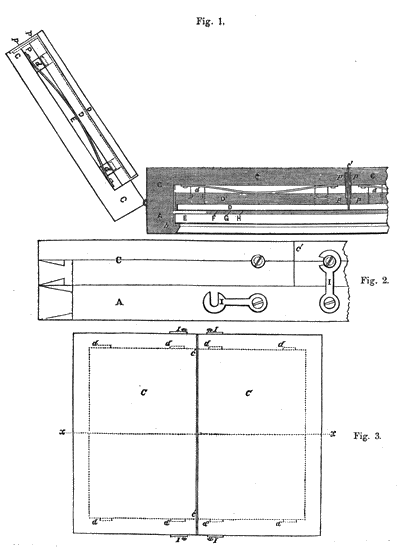
THE LIVERPOOL AND MANCHESTER PHOTOGRAPHIC JOURNAL. Vol. 1, 1852, p.189
WE have not yet had an opportunity of working with M. Belloc's patented printing-frame, but we do not the less hesitate to direct our readers' attention to the annexed drawings and description of it. We know enough of M. Belloc's zealous labours and painstaking character to warrant us in anticipating that his contrivance will be found to answer � fully the description he gives of it.
This frame is characterized,
1. By immediate, constant, and regular contact between the negative plate and the paper on which the positive is to be taken.
2. By a peculiar disposition of moveable shutters which admit of the most ready and easy manipulation. The invention is represented in the accompanying designs. Fig. I is a longitudinal section of the apparatus closed, and also showing the opening of the shutters: this section is taken along the line x x in fig. 3. Fig. 2 is a side view, showing the way of closing the moveable shutters. Fig. 3 is a plan of it shut.
The same letters show the same parts in the three figures. A is the frame: it may be made in wood or in any metal.
B is the large glass, on which the negative is placed. This glass rests on a frame of cork, b b, or on any other material not elastic or distending, to preserve an unvarying flatness and prevent fracture.
C C are the two shutters; they open on each side by hinges, which may be placed on the long or broad sides of the frames; in the former case the shutters open lengthways instead of breadthways. This, be it observed, makes no change in the principle of my apparatus.
These shutters can also be made of equal or unequal dimensions, so that the opening may be in any part of the frame, according as it is desired to look at the half or three-quarters of the picture.
D D are two plates of glass (which may be also of marble or metal, or any other hard substance), fixed in a wooden or metal frame, D'; this frame works in four grooves, d d d' d' connected with the shutter C. It is separated from this shutter by springs, E E. These springs are of any shape and of any elastic material; they may even be formed of an air-cushion, enclosed in a cover of caoutchouc, or anything else, which must be placed between the glasses D D, and the shutter C in which they slide.
These glasses are bevelled off along the edges which come into contact, so that they may not chip when they meet in the act of closing.
These same glasses can also be framed, to avoid the friction, and thus obtain the same result.
The part P is closed by means of two boards, p p', one fixed to the frame C, and the other to the frame D, and they slip one into the other, in order to prevent the pressure from penetrating into the part P.

Fig. 1